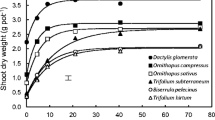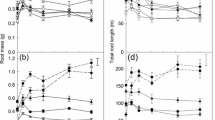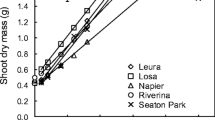Abstract
Brachiaria forage grasses are widely used for livestock production in the tropics. Signalgrass (Brachiaria decumbens cv. Basilisk, CIAT 606) is better adapted to low phosphorus (P) soils than ruzigrass (B. ruziziensis cv. Kennedy, CIAT 654), but the physiological basis of differences in low-P adaptation is unknown. We characterized morphological and physiological responses of signalgrass and ruzigrass to low P supply by growing both grasses for 30 days in nutrient solution with two levels of P supply using the hydroxyapatite pouch system. Ruzigrass produced more biomass at both levels of P supply whilst signalgrass appears to be a slower-growing grass. Both grasses increased biomass allocation to roots and had higher root acid phosphatase and phytase activities at low P supply. At low P supply, ruzigrass showed greater morphological plasticity as its leaf mass density and lateral root fraction increased. For signalgrass, morphological traits that are not responsive to variation in P supply might confer long-term ecological advantages contributing to its superior field persistence: greater shoot tissue mass density (dry matter content) might lower nutrient requirements while maintenance of lateral root growth might be important for nutrient acquisition in patchy soils. Physiological plasticity in nutrient partitioning between root classes was also evident for signalgrass as main roots had higher nutrient concentrations at high P supply. Our results highlight the importance of analyzing morphological and physiological trait profiles and determining the role of phenotypic plasticity to characterize differences in low-P adaptation between Brachiaria genotypes.






Similar content being viewed by others
References
Aerts R, Chapin FS III (2000) The mineral nutrition of wild plants revisited. A re-evaluation of processes and patterns. Adv Ecol Res 30:1–67
Aerts R, Van der Peijl MJ (1993) A simple model to explain the dominance of low-productive perennials in nutrient-poor habitats. Oikos 66:144–147
Arredondo JT, Johnson DA (1999) Root architecture and biomass allocation of three range grasses in response to nonuniform supply of nutrients and shoot defoliation. New Phytol 143:373–385
Boot RGA, Mensink M (1990) Size and morphology of root systems of perennial grasses from contrasting habitats as affected by nitrogen supply. Plant Soil 129:291–299
Chapin FS III (1980) The mineral nutrition of wild plants. Annu Rev Ecolog Syst 11:233–260
Chapin FS III (1983) Adaptation of selected trees and grasses to low availability of phosphorus. Plant Soil 72:283–287
Chapin FS III, Bieleski RL (1982) Mild phosphorus stress in barley and a related low-phosphorus adapted barley grass: phosphorus fractions and phosphate absorption in relation to growth. Physiol Plant 54:309–317
CIAT (1995) Biennial report 1994-1995. Tropical Forages. Working Document No. 152. CIAT, Cali, Colombia
CIAT (2007) Annual Report 2007. Improved multipurpose forages for the developing world. Outcome Line SBA3. CIAT, Cali, Colombia
Crick JC, Grime JP (1987) Morphological plasticity and mineral nutrient capture in two herbaceous species of contrasted ecology. New Phytol 107:403–414
Diatloff E, Rengel Z (2001) Compilation of simple spectrophotometric techniques for the determination of elements in nutrient solutions. J Plant Nutr 24:75–86
Duff SMG, Sarath G, Plaxton WG (1994) The role of acid phosphatases in plant phosphorus metabolism. Physiol Plant 90:791–800
George TS, Turner BL, Gregory PJ, Cade-Menun BJ, Richardson AE (2006) Depletion of organic phosphorus from Oxisols in relation to phosphatase activities in the rhizosphere. Eur J Soil Sci 57:47–57
Grime JP (1977) Evidence for the existence of three primary strategies in plants and its relevance to ecological and evolutionary theory. Am Nat 111:1169–1194
Grime JP, Mackey JML (2002) The role of plasticity in resource capture by plants. Evol Ecol 16:299–307
Gutschick VP, Kay LE (1995) Nutrient-limited growth rates: quantitative benefits of stress responses and some aspects of regulation. J Exp Bot 46:995–1009
Hammond JP, White PJ (2008) Sucrose transport in the phloem: integrating root responses to phosphorus starvation. J Exp Bot 59:93–109
Hammond JP, Broadley MR, White PJ (2004) Genetic responses to phosphorus deficiency. Ann Bot 94:323–332
Hayes JE, Richardson AE, Simpson RJ (1999) Phytase and acid phosphatase activities in extracts from roots of temperate pasture grass and legume seedlings. Austr J Plant Physiol 26:801–809
Helyar KR (1994) Edaphic constraints to perennial grasses: change the plant to suit the soil or vice versa. New Zeal J Agr Res 37:391–397
Hermans C, Hammond JP, White PJ, Verbruggen N (2006) How do plants respond to nutrient shortage by biomass allocation. Trends Plant Sci 11:610–617
Hodge A (2004) The plastic plant:root responses to heterogeneous supplies of nutrients. New Phytol 162:9–14
Hutchings MJ, De Kroon H (1994) Foraging in plants: the role of morphological plasticity in resource acquisition. Adv Ecol Res 25:159–238
Jackson RB, Pockman WT, Hoffman WA (1999) The structure and function of root systems. In: Pugnaire FI, Valladares F (eds) Handbook of functional plant ecology. Marcel Dekker, New York, pp 195–220
Jain A, Vasconcelos MJ, Raghothama KG, Sahi SV (2007) Molecular mechanisms of plant adaptation to phosphate deficiency. Plant Breed Rev 29:359–419
Lambers H, Shane MW, Cramer MD, Pearse SJ, Veneklaas EJ (2006) Root structure and functioning for efficient acquisition: matching morphological and physiological traits. Ann Bot 98:693–713
Marschner H (1998) Role of root growth, arbuscular mycorrhiza, and root exudates for the efficiency in nutrient acquisition. Field Crops Res 56:203–207
Miles JW, Do Valle CB, Rao IM, Euclides VPB (2004) Brachiariagrasses. In: Moser LE, Burson BL, Sollenberger LE (eds) Warm season (C4) Grasses. Agronomy Monograph no. 45. American Society of Agronomy, Crop Society of America, Soil Science of America, 677 S. Segoe Rd., Madison WI 53711, USA, pp 745–783
Nanamori M, Shinano J, Wasaki T, Yamamura T, Rao IM, Osaki M (2004) Low phosphorus tolerance mechanisms: phosphorus recycling and photosynthate partitioning in the tropical forage grass, Brachiaria hybrid cultivar Mulato compare with rice. Plant Cell Physiol 45:460–469
Poorter H, De Jong R (1999) A comparison of specific leaf area, chemical composition and leaf construction costs of field plants from 15 habitats differing in productivity. New Phytol 143:163–176
Poorter H, Nagel O (2000) The role of biomass allocation in the growth response of plant different levels of light, CO2, nutrients and water: a quantitative review. Austr J Plant Physiol 27:595–607
Poorter H, Van de Vijver CADM, Boot RGA, Lambers H (1995) Growth and carbon economy of a fast-growing and slow-growing species as dependent on nitrate supply. Plant Soil 171:217–227
R: A language and Environment for Statistical Computing (2006) R Foundation for Statistical Computing, Vienna, Austria
Rao IM (2002) Role of physiology in improving crop adaptation to abiotic stresses in the tropics: The case of common bean and tropical forages. In: Pessarakli M (ed) Handbook of plant and crop physiology. Marcel Dekker, New York, pp 583–613
Rao IM, Borrero V, Ricaurte J, García R, Ayarza MA (1996a) Adaptive attributes of tropical forage species to acid soils II. Differences in shoot and root growth responses to varying phosphorus supply and soil type. J Plant Nutr 19:323–352
Rao IM, Kerridge PC, Macedo M (1996b) Nutritional requirements of Brachiaria and adaptation to acid soils. In: Miles JW, Maass BL, DoValle CB (eds) Brachiaria: biology, agronomy and improvement. CIAT, Colombia, pp 53–71
Rao IM, Miles JW, Granobles JC (1998) Differences in tolerance to infertile acid soil stress among germplasm accessions and genetic recombinants of the tropical forage grass genus, Brachiaria. Field Crops Res 59:43–52
Rao IM, Borrero V, Ricaurte J, García R (1999a) Adaptive attributes of tropical forage species to acid soils V. Differences in phosphorus acquition from less available inorganic and organic sources of phosphate. J Plant Nutr 22:1175–1196
Rao IM, Friesen DK, Osaki M (1999b) Plant adaptation to phosphorus-limited tropical soils. In: Pessarakli M (ed) Handbook of plant and crop stress. Marcel Dekker, New York, pp 61–96
Ricaurte J, Rao IM, Menjívar C (2007) Estrategias de enraizamiento de genotipos Brachiaria en suelos ácidos y de baja fertilidad en Colombia. Acta Agronómica (Colombia) 56:107–115
Richardson AE, George TS, Hens M, Simpson RH (2005) Utilization of soil organic phosphorus by higher plants. In: Turner BL, Frossard E, Baldwin D (eds) Organic phosphorus in the environment. CABI Publishing, Wallington, pp 165–184
Rorison IH (1986) The response of plants to acid soils. Experientia 42:357–362
Ryser P (1996) The importance of tissue density for growth and leaf span of leaves and roots: a comparison of five ecologically contrasting grasses. Func Ecol 10:717–723
Ryser P, Aeschlimann U (1999) Proportional dry-mass content as an underlying trait for the variation in relative growth rate among 22 Eurasian populations of Dactylis glomerata s.l. Funct Ecol 13:473–482
Ryser P, Lambers H (1995) Root and leaf attributes accounting for the performance of fast- and slow-growing grasses at different nutrient supply. Plant Soil 170:251–265
Ryser P, Urbas P (2000) Ecological significance of leaf life span among Central European grass species. Oikos 91:41–50
Sanchez PA, Salinas JG (1981) Low input technology for managing Oxisols and Ultisols in tropical America. Adv Agron 34:280–406
Sas L, Tang C, Rengel Z (2001) Suitability of hydroxyapatite and iron phosphate as P sources for Lupinus albus grown in nutrient solution. Plant Soil 235:159–166
Schläpfer B, Ryser P (1996) Leaf and root turnover of three ecologically contrasting grass species in relation to their performance along a productivity gradient. Oikos 75:398–406
Valladares F, Gianoli E, Gómez JM (2007) Ecological limits to plant phenotypic plasticity. New Phytol 176:749–763
Vance CP, Uhde-Stone C, Allan DL (2003) Phosphorus acquisition and use: critical adaptations by plants for securing a nonrenewable resource. New Phytol 157:423–447
Vazquez de Aldana BR, Berendse F (1997) Nitrogen-use efficiency in six perennial grasses from contrasting habitats. Func Ecol 11:619–626
Wahl S, Ryser P (2000) Root tissue structure is linked to ecological strategies of grasses. New Phytol 148:459–471
Wenzl P, Mancilla LI, Mayer JE, Albert R, Rao IM (2003) Simulating infertile acid soils with nutrient solutions. The effects on Brachiaria species. Soil Sci Soc Am J 67:1457–1469
Wissuwa M, Gamat G, Ismail AM (2005) Is root growth under phosphorus deficiency affected by source or sink limitations? J Exp Bot 56:1943–1950
Zimmermann P, Zardi GI, Lehmann M, Zeder C, Amrhein N, Frossard E, Bucher M (2003) Engineering the root-soil interface via targeted expression of a synthetic phytase gene in trichoblasts. Plant Biotech J 1:353–360
Acknowledgements
Seeds of signalgrass and ruzigrass were provided by the International Center for Tropical Agriculture (CIAT), Cali, Colombia. This project is part of the research program of the North-South Centre of the Swiss Federal Institute of Technology (ETH-Zurich) “Livestock systems research in support of poor people”. It was jointly funded by ETH-Zurich and the Swiss Agency for Development and Cooperation (SDC).
Author information
Authors and Affiliations
Corresponding author
Additional information
Responsible Editor: Tim Simon George.
Rights and permissions
About this article
Cite this article
Louw-Gaume, A.E., Rao, I.M., Gaume, A.J. et al. A comparative study on plant growth and root plasticity responses of two Brachiaria forage grasses grown in nutrient solution at low and high phosphorus supply. Plant Soil 328, 155–164 (2010). https://doi.org/10.1007/s11104-009-0093-z
Received:
Accepted:
Published:
Issue Date:
DOI: https://doi.org/10.1007/s11104-009-0093-z




